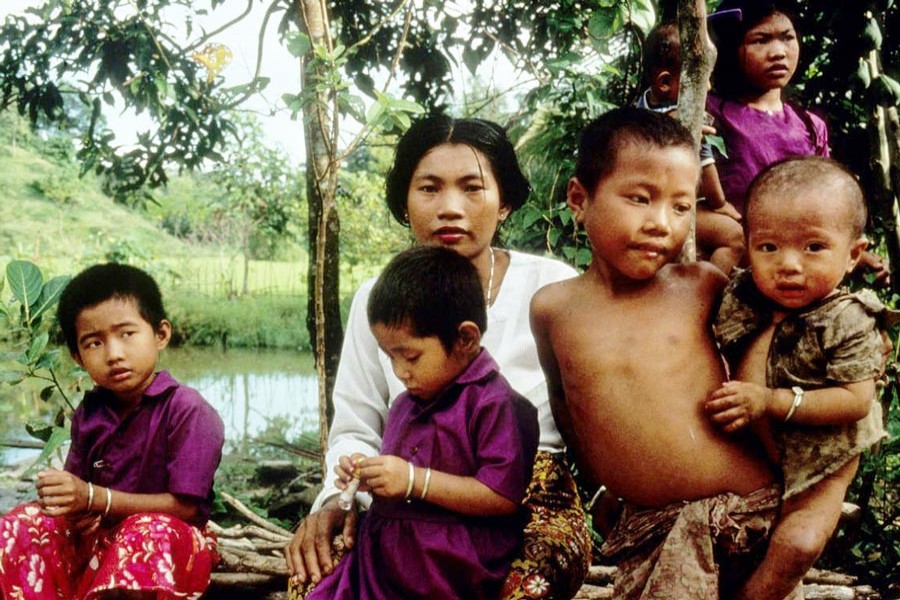The Chakma inhabited Chittagong Hill Tracts (CHT) in Bangladesh and its neighbouring regions in India and Myanmar. They belong to the Tibeto-Burman (TB) ethnic folk, though they speak one of the Indo-Aryan varieties having similarity with the Chattogram variety of Bangla. Despite being the TB folk, how they turned to be an Indo-Aryan speech community remains a mystery. This unresolved mystery has recently been revealed from a research conducted at the Institute of Modern Language, University of Dhaka.
According to the write-up of Sugoto Chakma, a former director of the Khudra Nrigostir Cultural Institute, the Chakma is a pro-Buddhist TB ethnic community comprising 31 different goza (meaning clan). The speech variety they speak has been named Chakma after their folk name Chakma. The fact that the Chakma being a TB ethnic folk used to speak an Indo-Aryan creole, which indicates that the Chakma was a TB speech community in the past, but shifted to an Indo-Aryan variety in course of time. This assumption can be justified with the theory of language contact as given by Donald Winford, a Caribbean anthropological linguist. According to the theory of language contact, when different speech communities come into social contact, they use an intermediary lingua franca which they create anew by their own or they borrow from others for the intergroup communication. When a lingua franca of such a kind is created anew, it persists with few words embodied in simple grammatical structures known as pidgin, which in course of time developed to a simplified form of natural language called Creole, which further developed to a full-fledged language, if the language situation exists in favour of that newly formed Creole.
Given the above backdrop of the development of a new language, we can find some support, in favour of the creation of Chakma variety from Indo-Aryan variety in a Chakma legend. According to a folk-tale, a Chakma prince and his disciples having been ousted by his rival enthroned brother settled in CHT and married to the local women of unalike TB folk. Having risen to the power as a king, he tried to consolidate power in order to assert political authority among the dispersed clans of TB folks. In consolidating power, he introduced a local Indo-Aryan variety, i.e. Chittagong variety as a common means of communication and a common religion of Aryan origin, i.e. Buddhism, which gave Pali language a way to be their own language. This maneuver by the rising king consequently opened a way for the Aryanisation of TB ethno-lingual tribal folks, while Aryanisation is taken to be understood as the conversion from primitive belief to Buddhism and shifting to an Indo-Aryan speech variety. As it is the case in the development of kingdom/empire in other political settings, the assimilation of the 31 TB clans compounded with the process of Aryanisation occurred under the political maneuver by the leadership of above-said Chakma king. This process of Aryanisation likely enabled the 31 different clans of TB communities to be assimilated in a post-tribal society and to accept an Indo-Aryan speech variety as a common means of communication. Accordingly, this process can be seen as two sub-processes: i) the assimilation of different 31 different TB variety speaking clans into a single post-tribal society as well as ii) the creation of a pidgin for intergroup communication among the clans, which enable the TB people of different clans to be integrated and fused into a post-tribal society.
On the basis of the above discussion, it can be postulated that the Chakma as a tribe has been created out of different TB speech communities under a kingly policy of political maneuver. While the TB people have been assimilated into a larger community, they had no common language for which they would use a variety of Bangla borrowed from their neighbouring region, i.e. Chittagong. As they would use Chittagong variety, they created their own variety for communication by absorbing some linguistic features of TB languages in their speech, for which some TB features still remain in their Chakma speech variety. Hence, Chakma variety has been created out of the Indo-Aryan variety to which the post-tribal Chakma folk shifted by surrendering their ancestral speech in course of time. Though Chakma is thought to be a language, it is actually not a language in consideration of criteria of being a language. It is rather a dialect of Bangla, because its linguistic structure mostly resembles the Chittagong variety of Bangla language.
Once Chakma variety appeared as natural speech variety, it further developed to a full-fledged language following a process called revitalisation. It was first transcribed in Mon-Khmer scripts around the year 1777 for the first time, the year which can be called the time of onset of orthographic development of Chakma, and is now often written in Bangla scripts. The revitalisation of Chakma is still being undergone by borrowing vocabularies and grammars from Bangla. Since it has originated from the dialect of Bangla and the enrichment of it has still been occurring with the elements borrowed from Bangla language, it neither can be called an indigenous language and its speakers nor can be called indigenous people.
ABM Razaul Karim Faquire, PhD is a Professor of Japanese Language & Culture at the Institute of Modern Languages of the University of Dhaka.
[email protected]


